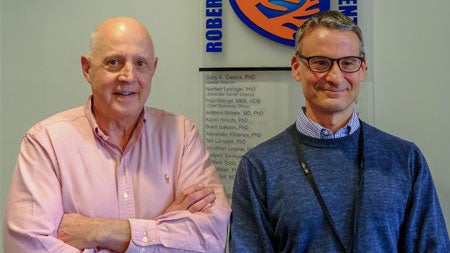
(From left) Ken Walsh, PhD, and Ariel Polizio, PhD
Understanding the origins of medication-resistant hypertension is the focus of a new research by Ariel Polizio, PhD, a scientist in the lab of Ken Walsh, PhD, professor of research in internal medicine and resident faculty in the UVA Robert M. Berne Cardiovascular Research Center. They recently published work in the journals Circulation Research and Hypertension about the impact of clonal hematopoiesis (CH) on hypertension and a promising new treatment through renal denervation.
Up to 50% of patients demonstrate resistance to medications prescribed for high blood pressure, increasing their chances of developing organ damage through mechanisms including heart failure, stroke, and fibrosis. Polizio, with training as a pharmacist and a PhD in biochemistry, recognized an opportunity to contribute to this research by working with Walsh, an expert in clonal hematopoiesis.
CH is a process wherein blood stem cells accumulate mutations over time. These mutations allow a subgroup of cells to outcompete their non-mutated counterparts. In extreme cases, over 20% of a patients’ circulating immune cells can be clones of a single mutant cell. These mutations accumulate naturally over a person’s life and, until recently, their potential impact on health was largely neglected. Walsh is at the forefront of demonstrating how CH can contribute to age-related cardiovascular disease. Hypertension cases also increase with age, leading Polizio to suspect CH could play a role in its progression.
In 2019, Polizio joined UVA from CONICET in Argentina, the country’s premier scientific program, to study the role of CH in drug-resistant hypertension. Starting the project was a challenge because Polizio was not a trained immunologist.
“I had to start over again,” he explained. “I’m fascinated by the relationship between immunology and cardiovascular disease because hypertension is a systemic disease. It involves all the organs of the body. I love UVA’s Cardiovascular Research Center because if you need something you don’t know, they can help you and complement your expertise. Now, I’ve learned a lot and have the freedom to explore diverse avenues within immunology.”
Polizio and Walsh soon identified an important gene modified by CH that was correlated with hypertension: TET2. TET2 plays a crucial role in regulating gene expression, and when mutated or deleted, it is a hallmark of age-related CH. While TET2 mutations are also observed in certain pre-leukemic and lymphoma conditions, Polizio and Walsh’s research focused on the direct impact of TET2 mutations in CH on cardiovascular health.
In the case of hypertension, Polizio and Walsh showed that TET2 mutations in mice lead to sodium retention, inflammation, and increased immune activity. The immune activity changed behavior in the kidneys, which in turn exacerbated hypertension. Using drugs to suppress the immune reaction in the kidneys also improved hypertension.
“There was the connection between CH and hypertension, but not the mechanism,” Polizio said. “I’m fascinated to know what happens from beginning to end, so this is a very exciting work.” This work was published in Circulation Research alongside an editorial article the journal commissioned to highlight the significance of the work.
In a follow-up study, Polizio went on to show that the effects of CH-exacerbated hypertension can be mitigated by renal denervation, a minimally invasive surgery that cuts a nerve in the kidneys. Renal denervation recently passed clinical trials in humans and is a method for treating medication-resistant hypertension. The work on renal denervation was published in the journal Hypertension.
Going forward, Polizio and Walsh will study how autoimmune diseases interact with CH and hypertension. Patients with systemic autoimmune diseases often suffer from hypertension, and Polizio wants to understand what role CH might be playing in the process. Additionally, though he now works in cardiology and immunology, Polizio hasn’t forgotten his scientific roots. “I’m pharmacist also, so I’m always trying to look some therapeutics to prevent the consequences of hypertension and CH.”
Learn more about the Walsh Lab at the School of Medicine’s Robert M. Berne Cardiovascular Research Center, Division of Cardiovascular Medicine.
Filed Under: Research
